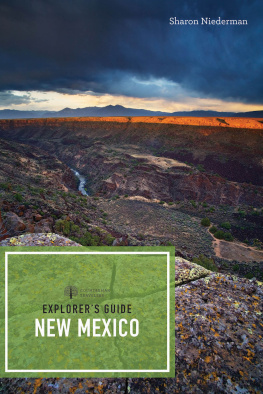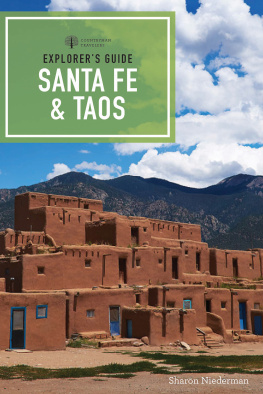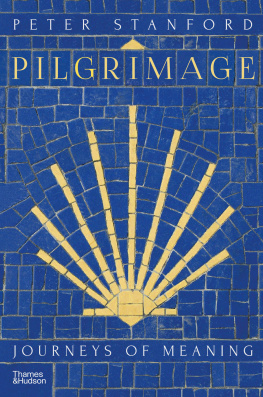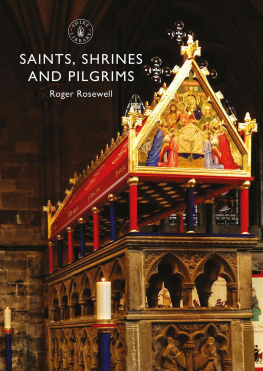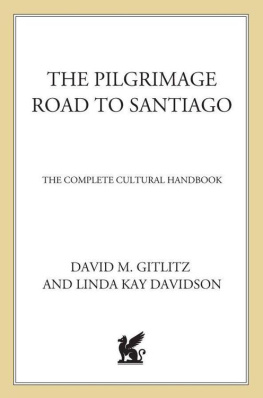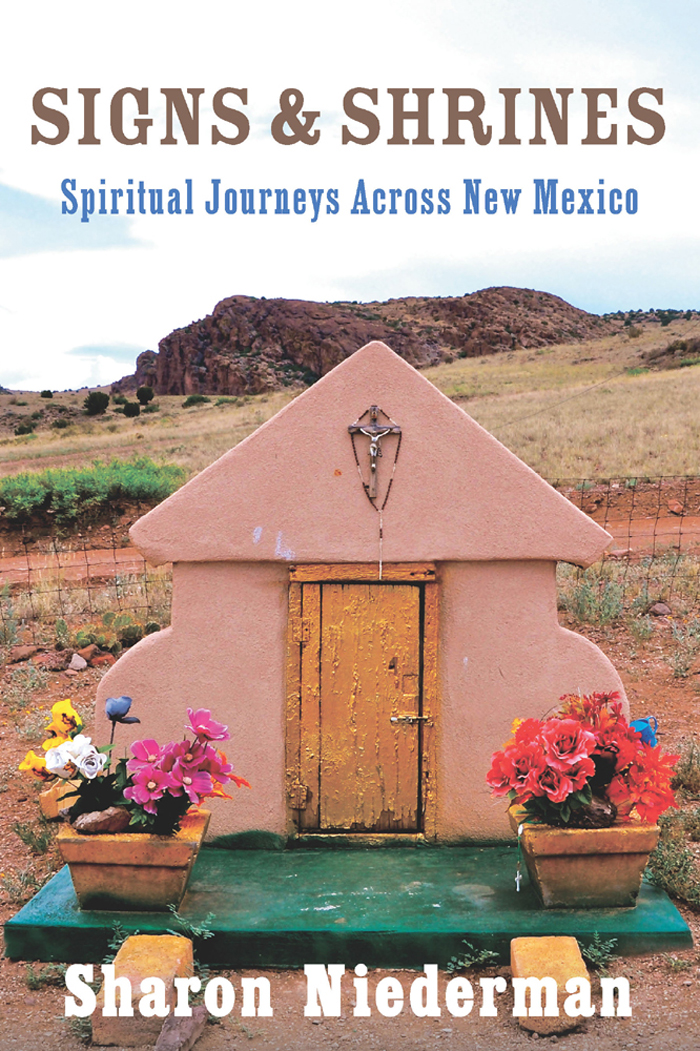Copyright 2012 by Sharon Niederman
All rights reserved. No part of this book may be reproduced in any form or by any electronic or mechanical means including information storage and retrieval systems without permission in writing from the publisher, except by a reviewer, who may quote brief passages.
Interior photographs by the author unless otherwise specified Map by Erin Greb Cartography, The Countryman Press Book design and composition by Susan Livingston
Signs & Shrines
ISBN: 978-0-88150-908-3
Published by The Countryman Press,
P.O. Box 748, Woodstock, VT 05091
Distributed by W. W. Norton & Company, Inc.,
500 Fifth Avenue, New York, NY 10110
Printed in the United States of America
10 9 8 7 6 5 4 3 2 1
Right: New Mexicos landforms convey a sense of the sacred and eternal. The Ghost Ranch landmark, Pedernal, is in the background.
ALSO BY THE AUTHOR
The Santa Fe and Taos Book: Great Destinations
New Mexico: An Explorers Guide
New Mexicos Tasty Traditions:
Recollections, Recipes, and Photos
Return to Abo: A Novel of the Southwest
A Quilt of Words: Womens Diaries, Letters,
and Original Accounts of Life in the Southwest 18601960
1
The Old Spanish Trail:
ABIQUIU TO CHAMA
T he Old Spanish Trail, one of the most arduous and lesser-known 19th-century trails west, commenced in 1828 in Abiquiu, at a trailhead approximately on the site of what is today Bodes General Store (see entry under Nourish). The Old Spanish Trail Association, a historic-preservation group, placed a trail map on the wall of Bodes trading post to honor the route. Trailblazing Santa Fe merchant Antonio Armijo here assembled 60 men and 100 mules for the journey to San Gabriel Mission in California.
Incorporating Indian trails and other historic routes, Armijo led the pack trail from Santa Fe to Los Angeles, creating a land route between the two Spanish provinces of New Mexico and California. Used primarily for trade until 1848, the route saw the transport of sheep and woven woolen goods to California, where they were exchanged for horses, mules, and Genzaros, detribalized Indians who were sold or traded as slaves in the New Mexico market, where they were incorporated into the households and ranchos of Spanish settlers, and converted to Catholicism.
Abiquiu, located 53 miles from Santa Fe and built on an abandoned pueblo above the Rio Chama, is known as a center for the descendants of Genzaros; in 1754, 34 Genzaro families received a 16,000-acre land grant for grazing and timber, and much of the population today traces its ancestry to this mixed tribal-Spanish heritage. While July 3 is the feast day of their patron saint, Santo Toms, the annual celebration takes place on the weekend following Thanksgiving, in Abiquiu Plaza.
The name Abiquiu comes from the 13th-century Indian pueblo known as Ave shu. The word Genzaro comes from the Turkish yeni cheri, meaning new troops, a reference to slaves trained as soldiers in the Ottoman Empire. Strong beliefs in witchcraft and sorcery endured among the Genzaros, and these beliefs triggered a reaction from the Church, which strove to bring the Genzaros in line with traditional teachings. In what was essentially a clash of cultures, belief in traditional healing methods was suppressed, but not quite eradicated, by the Church. In addition, the Abiquiu population was, and remains, a fierce stronghold of Penitente culture (see sidebar, p. 71). Consequently, many of the sheep-herders and travelers across the Old Spanish Trail were practicing Penitentes.
To learn more about the Old Spanish Trail, see the 1954 book by that name by Le Roy R. Hafen and Ann W. Hafen. The Old Spanish Trail Association, which holds an annual conference and publishes quarterly newsletters, may be contacted at 505-425-6039, or visit www.oldspanishtrail.org.
Let us follow the Chama River as it winds through northwest New Mexico from Abiquiu to Chama along US 84. Along the Old Spanish Trail these days youll find the spiritual retreats of Ghost Ranch and the Monastery of Christ in the Desert; fishing at Abiquiu Lake; Rio Grande weaving at Los Ojos; and the Cumbres and Toltec Scenic Railroad in Chama, among other noteworthy attractions.

The Abiquiu Morada endures on a hill above the Rio Chama as a symbol of Penitente culture.
GUIDANCE
Chama Valley Chamber of Commerce (800-477-0149 or 575-756-2306; www.chamavalley.com) Chama New Mexico Visitor Center (800-982-8679; www.chama.net) Health Centers of Northern New Mexico 211 N. Pine, Chama (575-756-2144)
DISCOVER
Florence Hawley Ellis Museum of Anthropology Ghost Ranch Conference Center, 1708 US 84, Abiquiu (575-685-4333; www.newmexico-ghostranch.org/museums.html) Named for a pioneer anthropologist, this museum specializes in excavated materials from more than 12,000 years of habitation in the region. The adjacent Ruth Hall Museum of Paleontology celebrates the Coelophysis dinosaur found here, the little dinosaur that is the state fossil. Museums open summer Tues.Sat. 95, Sun.Mon. 15; winter Tues.Sat. 95. $4 adults, $1 children and seniors.
Ghost Ranch Piedra Lumbre Education and Visitor Center (575-685-4312; www.ghostranch.org/museums-and-activities/piedra-lumbre) US 84 between mile markers 225 and 226, just north of Ghost Ranch, Abiquiu. Open daily Mar.Oct. 95; Nov.Feb. Sat.Sun. only. Exhibits on the paleontology, archaeology, and geology of the region, as well as the Old Spanish Trail, the Jicarilla Apache, and Georgia OKeeffe. Free.
Georgia OKeeffe Home and Studio Abiquiu (505-946-1000; www.okeeffemuseum.org/her-houses.html) Small group tours available by reservation only, Tues., Thurs., Fri. mid-MarchNov. Additional tours Wed. and Sat. JuneOct. $3545. Reserve well ahead.
Echo Amphitheater 18 miles north of Abiquiu on US 84. A remarkable natural red sandstone amphitheater-shaped formation where echoes resound. A few campsites and short, easy hiking trail make for a good leg stretch.
Dar Al-Islam (575-685-4515; www.daralislam.org) North of Ghost Ranch Abiquiu off CR 155 at sign 42A. Built by renowned adobe architect Hassan Fathy, this American Muslim community hosts the annual North American Muslim Powwow in June. Visitors are restricted. Call for hours.
Pedernal 27 miles northwest of Espanola on US 84. Go west (left) on NM 96 11.5 miles. At small sign for Forest Road 100 go left 5.7 miles. You can hike 3 miles to the base. The mesa is one of the best-known natural landmarks in northern New Mexico. The name means flint mountain. It is where the ancient peoples gathered the valuable stone used to make hunting points. The flat-top mountain was a favorite subject of Georgia OKeeffe, who said, God told me that if I painted it often enough, He would give it to me.
Brazos Cliffs Visible to the east of US 84, just south of Chama, these striking cliffs of sheer Precambrian quartzite are popular with climbers. The Brazos River is a destination beloved of fishermen.
RECREATE
Lone Pine Outfitters 803 W. 3rd St., Chama (575-756-2992) Hunting, trail rides, and overnight trips may be easily planned here.


